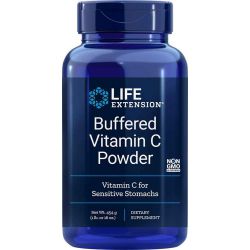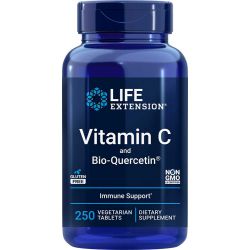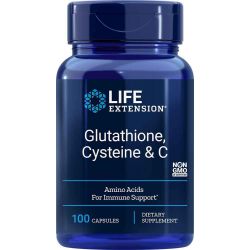Hochdosiertes Vitamin C – ein neuer therapeutischer Ansatz
Hochdosiertes Vitamin C – ein neuer therapeutischer Ansatz

Leider nehmen viele Menschen nicht genug Vitamin C zu sich. Die meisten Erwachsenen gehen fälschlicherweise davon aus, dass die vom Bund empfohlenen 75-90 mg Vitamin C eine optimale Tagesdosis sind. Tatsächlich reicht diese „empfohlene Nahrungsergänzung“ nur aus, um Erkrankungen des Vitaminmangels wie Skorbut vorzubeugen. Sie ist aber nicht ausreichend genug, um eine optimale Gesundheit zu unterstützen.
Der mit dem Nobelpreis ausgezeichnete Wissenschaftler Dr. Linus Pauling war einer der ersten, der vor über 30 Jahren die Bedeutung einer hochdosierten Vitamin-C-Supplementation erkannt hatte. Seitdem haben Wissenschaftler eindrucksvolle Beweise gesammelt, die die zahlreichen Vorteile von hoher Dosierung von Vitamin C belegen.
Vitamin C unterdrückt Zellschäden, fördert die Gesundheit des Immunsystems
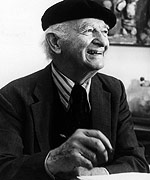
Vitamin C hilft bei der Vorbeugung und Bekämpfung von Infektionen


Die vielfältigen Wirkungen von Vitamin C beim Schutz vor Herz-Kreislauf-Erkrankungen können zum Teil für die starke Verbindung zwischen einer optimalen Vitamin-C-Aufnahme und einer längeren Lebensdauer verantwortlich sein.
In einer großen Studie mit mehr als 19.000 Erwachsenen im Alter von 45-79 Jahren starben zum Beispiel doppelt so viele Menschen mit den niedrigsten Plasmaspiegeln an Vitamin C im Vergleich zu denjenigen mit den höchsten Spiegeln.15 Die Zahl der Todesfälle, die von Herz-Kreislauf-Erkrankungen verursacht wurden, nahm ab, da der Vitamin-C-Spiegel im gesamten Bereich des Vitamin-C-Spiegels im Plasma anstieg. Selbst für Alter, Blutdruck, Cholesterinspiegel, Zigarettenrauchen, Diabetes und die Verwendung von Nahrungsergänzungsmitteln beobachtete man den Anstieg der Vitamin-C-Plasmaspiegel und die Senkung des Todesfalls um 20% .
In ähnlicher Weise zeigte eine 10-Jahres-Studie von UCLA, dass bei einer Bevölkerung von mehr als 11.000 US-amerikanischen Erwachsenen zwischen 25 und 74 Jahren Männer, die täglich 800 mg Vitamin C einnahmen, etwa sechs Jahre länger lebten als Männer, die täglich nur 60 mg Vitamin C einnahmen .16 Selbst nach einer Kontrolle des Rauchens, der Bildung, der Rasse, von Krankheiten und anderen Faktoren, die das Überleben beeinflussen, prognostizierte eine erhöhte Vitamin-C-Zufuhr bei Männern immer noch eine niedrigere Mortalität. Eine erhöhte Vitamin-C-Zufuhr war bei Frauen ebenfalls mit einer längeren Lebensdauer verbunden. Eine höhere Vitamin-C-Aufnahme reduzierte die kardiovaskulären Todesfälle bei Männern um 42% und bei Frauen um 25%.
Das Reißen von atherosklerotischer Plaque (Fettansammlung) in der Arterienwand kann fatale Folgen haben, einschließlich des plötzlichen Todes eines Herzinfarkts. Tierstudien legen nahe, dass ein chronischer Vitamin-C-Mangel zur Bildung von instabilen arteriellen Plaques beiträgt, die wahrscheinlicher zu lebensbedrohlichen kardiovaskulären Ereignissen führen.17 Dieser Zusammenhang lässt auf ein weiteres Beispiel schließen, wie der kardioprotektive Nutzen von Vitamin C zu einer längeren und gesünderen Lebenszeit beitragen kann.
Vitamin C unterstützt die Endothelfunktion und schützt das Herz

Vitamin C senkt das Risiko für koronare Herzkrankheiten
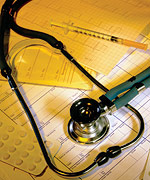
Vitamin-C-Status an Herzinfarktrisiko gebunden

Vitamin C reduziert auch die durch Herzinfarkte verursachten Schäden
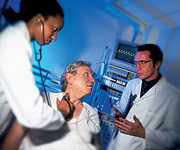

Neue Forschungsergebnisse deuten darauf hin, dass Vitamin C eine Reihe unerwarteter gesundheitlicher Vorteile bieten kann, von der Steigerung der Überlebensrate bei Krebs bis zur Förderung der Knochengesundheit.
Steigerung der Überlebensrate. Der Kampf gegen Krebs ist für manche Patienten sehr erschöpfend. Wissenschaftler haben ein Ernährungshilfsmittel entdeckt, von denen solche Patienten profitieren können. Forscher berichteten kürzlich, dass die Verabreichung von hochdosiertem, intravenösem Vitamin C an mehrere Patienten mit fortgeschrittenem Krebs im Endstadium zu unerwartet langen Überlebenszeiten führte. Diese Ergebnisse stützen frühere Berichte, die zeigen, dass hochdosiertes Vitamin C, das entweder oral oder intravenös verabreicht wurde, zur Verbesserung der Symptome und zur Verlängerung des Lebens von Krebspatienten beigetragen hat.47
Abwendung von Nierenschäden. Eine Nierenfunktionsstörung ist äußerst häufig und wird häufig nicht erkannt. Dies kann zu dauerhaften Schäden am Filtergerät der Nieren führen. Ernährungswissenschaftler berichten, dass Vitamin C helfen kann, das Fortschreiten einer Nierenfunktionsstörung im Zusammenhang mit der Vernarbung der Nierengefäße zu verhindern oder zu stoppen. Dieser Befund kann besonders wichtig für Diabetiker sein, die besonders anfällig für diese Art von Nierenschaden sind.48
Bekämpfung von Asthma. Asthma-Fälle haben in den letzten Jahren dramatisch zugenommen. Wissenschaftler haben beobachtet, dass bei Erwachsenen mit chronischem Asthma es häufig an Vitamin C fehlt. Asthma-freie Probanden zeigen dagegen gesunde Mengen an Vitamin C. Die Optimierung des Vitamin C-Niveaus bei Asthma-Anfälligen könnte daher für die Befreiung von dieser schwächenden Erkrankung von entscheidender Bedeutung sein.49
Förderung gesunder Knochen. Ein weiterer Vorteil von Vitamin C scheint seine Fähigkeit zu sein, die Knochendichte zu erhöhen. Wissenschaftler haben kürzlich eine erhöhte Aufnahme von Vitamin C-haltigen Früchten mit einer höheren Knochendichte bei jüngeren und älteren Menschen korreliert.50
Diese Feststellung unterstützt frühere Berichte, dass die Einnahme von Vitamin C mit Markern einer erhöhten Knochenbildung einhergeht und dass deren Einnahme ab der Pubertät eine wichtige Rolle bei der Verhinderung von Osteoporose spielen kann.51 Bekämpfung der Herpes-simplex-Infektion. Das Herpes-simplex-Virus kann zu wiederkehrenden, schmerzhaften Haut- und Schleimhautverletzungen führen. Forscher haben berichtet, dass Ernährungstherapien, einschließlich Vitamin C, dazu beitragen können, die Auflösung von Herpes-Simplex-Läsionen zu beschleunigen und deren Wiederauftreten zu verhindern.52
Verhinderung eines anormalen Herzrhythmus. Viele Menschen sind von Vorhofflimmern betroffen, einer Herzrhythmusstörung, die das Schlaganfallrisiko erhöht. Forscher haben vorgeschlagen, dass oxidativer Stress bei dieser Abnormalität eine Rolle spielen kann, was auf eine therapeutische Rolle für Antioxidantien schließen lässt. Aufregende Vorstudien legen nahe, dass Vitamin C das Vorhofflimmern abwehren kann, möglicherweise durch seine Fähigkeit, oxidativen Stress abzubauen.53
Vitamin C reduziert die Gefahren von Blutlipiden

Die empfohlene Diätdosis (RDA) für Vitamin C beträgt 75 mg für Frauen und 90 mg für Männer pro Tag. Da reichhaltige Daten darauf schließen lassen, dass weitaus größere Dosen erforderlich sind, um eine optimale Gesundheit zu unterstützen, empfiehlt Life Extension die tägliche Einnahme von 1000-6000 mg Vitamin C zu den Mahlzeiten.
Fazit
1. Hemila H. Vitamin C supplementation and the common cold—was Linus Pauling right or wrong? Int J Vitam Nutr Res. 1997;67(5):329-35.
2. Davison G, Gleeson M. Influence of acute vitamin C and/or carbohydrate ingestion on hormonal, cytokine, and immune responses to prolonged exercise. Int J Sport Nutr Exerc Metab. 2005 Oct;15(5):465-79.
3. Hemila H. Vitamin C and common cold incidence: a review of studies with subjects under heavy physical stress. Int J Sports Med. 1996 Jul;17(5):379-83.
4. Eguchi M, Miyazaki T, Masatsuji-Kato E, et al. Cytoprotection against ischemia-induced DNA cleavages and cell injuries in the rat liver by pro-vitamin C via hydrolytic conversion into ascorbate. Mol Cell Biochem. 2003 Oct;252(1-2):17-23.
5. Furumoto K, Inoue E, Nagao N, Hiyama E, Miwa N. Age-dependent telomere shortening is slowed down by enrichment of intracellular vitamin C via suppression of oxidative stress. Life Sci. 1998;63(11):935-48.
6. Loguercio C, Cuomo A, Tuccillo C, et al. Liver p53 expression in patients with HCV-related chronic hepatitis. J Viral Hepat. 2003 Jul;10(4):266-70.
7. Yokoo S, Furumoto K, Hiyama E, Miwa N. Slow-down of age-dependent telomere shortening is executed in human skin keratinocytes by hormesis-like-effects of trace hydrogen peroxide or by anti-oxidative effects of pro-vitamin C in common concurrently with reduction of intracellular oxidative stress. J Cell Biochem. 2004 Oct 15;93(3):588-97.
8. Wintergerst ES, Maggini S, Hornig DH. Immune-enhancing role of vitamin C and zinc and effect on clinical conditions. Ann Nutr Metab. 2006;50(2):85-94.
9. Hemila H. Vitamin C supplementation and respiratory infections: a systematic review. Mil Med. 2004 Nov;169(11):920-5.
10. Gorton HC, Jarvis K. The effectiveness of vitamin C in preventing and relieving the symptoms of virus-induced respiratory infections. J Manipulative Physiol Ther. 1999 Oct;22(8):530-3.
11. Hemila H, Douglas RM. Vitamin C and acute respiratory infections. Int J Tuberc Lung Dis. 1999 Sep;3(9):756-61.
12. Petersen EE, Magnani P. Efficacy and safety of vitamin C vaginal tablets in the treatment of non-specific vaginitis. A randomised, double blind, placebo-controlled study. Eur J Obstet Gynecol Reprod Biol. 2004 Nov 10;117(1):70-5.
13. Salgueiro J, Zubillaga M, Goldman C, et al. Review article: is there a link between micronutrient malnutrition and Helicobacter pylori infection? Aliment Pharmacol Ther. 2004 Nov 15;20(10):1029-34.
14. Kim HJ, Kim MK, Chang WK, et al. Effect of nutrient intake and Helicobacter pylori infection on gastric cancer in Korea: a case-control study. Nutr Cancer. 2005;52(2):138-46.
15. Khaw KT, Bingham S, Welch A, et al. Relation between plasma ascorbic acid and mortality in men and women in EPIC-Norfolk prospective study: a prospective population study. European Prospective Investigation into Cancer and Nutrition. Lancet. 2001 Mar 3;357(9257):657-63.
16. Enstrom JE, Kanim LE, Klein MA. Vitamin C intake and mortality among a sample of the United States population. Epidemiology. 1992 May;3(3):194-202.
17. Nakata Y, Maeda N. Vulnerable atherosclerotic plaque morphology in apolipoprotein E-deficient mice unable to make ascorbic Acid. Circulation. 2002 Mar 26;105(12):1485-90.
18. Kim DS, Lee MS, Kim YS, et al. Effect modification by vitamin C on the relation between gastric cancer and Helicobacter pylori. Eur J Epidemiol. 2005;20(1):67-71.
19. Harakeh S, Jariwalla RJ. Comparative study of the anti-HIV activities of ascorbate and thiol-containing reducing agents in chronically HIV-infected cells. Am J Clin Nutr. 1991 Dec;54(6 Suppl):1231S-5S.
20. Muller F, Svardal AM, Nordoy I, et al. Virological and immunological effects of antioxidant treatment in patients with HIV infection. Eur J Clin Invest. 2000 Oct;30(10):905-14.
21. Rivas CI, Vera JC, Guaiquil VH, et al. Increased uptake and accumulation of vitamin C in human immunodeficiency virus 1-infected hematopoietic cell lines. J Biol Chem. 1997 Feb 28;272(9):5814-20.
22. Chambers JC, McGregor A, Jean-Marie J, Obeid OA, Kooner JS. Demonstration of rapid onset vascular endothelial dysfunction after hyperhomocysteinemia: an effect reversible with vitamin C therapy. Circulation. 1999 Mar 9;99(9):1156-60.
23. Plotnick GD, Corretti MC, Vogel RA. Effect of antioxidant vitamins on the transient impairment of endothelium-dependent brachial artery vasoactivity following a single high-fat meal. JAMA. 1997 Nov 26;278(20):1682-6.
24. Kinugawa S, Post H, Kaminski PM, et al. Coronary microvascular endothelial stunning after acute pressure overload in the conscious dog is caused by oxidant processes: the role of angiotensin II type 1 receptor and NAD(P)H oxidase. Circulation. 2003 Dec 9;108(23):2934-40.
25. Tousoulis D, Xenakis C, Tentolouris C, et al. Effects of vitamin C on intracoronary L-arginine dependent coronary vasodilatation in patients with stable angina. Heart. 2005 Oct;91(10):1319-23.
26. Katayama Y, Shige H, Yamamoto A, Hirata F, Yasuda H. Oral vitamin C ameliorates smoking-induced arterial wall stiffness in healthy volunteers. J Atheroscler Thromb. 2004;11(6):354-7.
27. Schindler TH, Nitzsche EU, Munzel T, et al. Coronary vasoregulation in patients with various risk factors in response to cold pressor testing: contrasting myocardial blood flow responses to short- and long-term vitamin C administration. J Am Coll Cardiol. 2003 Sep 3;42(5):814-22.
28. Varadharaj S, Steinhour E, Hunter MG, et al. Vitamin C-induced activation of phospholipase D in lung microvascular endothelial cells: Regulation by MAP kinases. Cell Signal. 2006 Sep;18(9):1396-407.
29. Nam CM, Oh KW, Lee KH, et al. Vitamin C intake and risk of ischemic heart disease in a population with a high prevalence of smoking. J Am Coll Nutr. 2003 Oct;22(5):372-8.
30. Knekt P, Ritz J, Pereira MA, et al. Antioxidant vitamins and coronary heart disease risk: a pooled analysis of 9 cohorts. Am J Clin Nutr. 2004 Dec;80(6):1508-20.
31. Osganian SK, Stampfer MJ, Rimm E, et al. Vitamin C and risk of coronary heart disease in women. J Am Coll Cardiol. 2003 Jul 16;42(2):246-52.
32. Nyyssonen K, Parviainen MT, Salonen R, Tuomilehto J, Salonen JT. Vitamin C deficiency and risk of myocardial infarction: prospective population study of men from eastern Finland. BMJ. 1997 Mar 1;314(7081):634-8.
33. Lopes C, Von HP, Ramos E, et al. Diet and risk of myocardial infarction. A case-control community-based study. Acta Med Port. 1998 Apr;11(4):311-7.
34. Riemersma RA, Carruthers KF, Elton RA, Fox KA. Vitamin C and the risk of acute myocardial infarction. Am J Clin Nutr. 2000 May;71(5):1181-6.
35. Jaxa-Chamiec T, Bednarz B, Drozdowska D, et al. Antioxidant effects of combined vitamins C and E in acute myocardial infarction. The randomized, double-blind, placebo controlled, multicenter pilot Myocardial Infarction and VITamins (MIVIT) trial. Kardiol Pol. 2005 Apr;62(4):344-50.
36. Senthil S, Veerappan RM, Ramakrishna RM, Pugalendi KV. Oxidative stress and antioxidants in patients with cardiogenic shock complicating acute myocardial infarction. Clin Chim Acta. 2004 Oct;348(1-2):131-7.
37. Matsumoto H, Inoue N, Takaoka H, et al. Depletion of antioxidants is associated with no-reflow phenomenon in acute myocardial infarction. Clin Cardiol. 2004 Aug;27(8):466-70.
38. Bednarz B, Chamiec T, Ceremuzynski L. Antioxidant vitamins decrease exercise-induced QT dispersion after myocardial infarction. Kardiol Pol. 2003 May;58(5):375-9.
39. Morel O, Jesel L, Hugel B, et al. Protective effects of vitamin C on endothelium damage and platelet activation during myocardial infarction in patients with sustained generation of circulating microparticles. J Thromb Haemost. 2003 Jan;1(1):171-7.
40. Gasparetto C, Malinverno A, Culacciati D, et al. Antioxidant vitamins reduce oxidative stress and ventricular remodeling in patients with acute myocardial infarction. Int J Immunopathol Pharmacol. 2005 Jul;18(3):487-96.
41. Kato K, Fukuma N, Kimura-Kato Y et al. Improvement of sympathetic response to exercise by oral administration of ascorbic acid in patients after myocardial infarction. Int J Cardiol. 2005 Oct 20; [Epub ahead of print].
42. Liu P, Xu B, Cavalieri TA, Hock CE. Age-related difference in myocardial function and inflammation in a rat model of myocardial ischemia-reperfusion. Cardiovasc Res. 2002 Dec;56(3):443-53.
43. Liu P, Xu B, Cavalieri TA, Hock CE. Attenuation of antioxidative capacity enhances reperfusion injury in aged rat myocardium after MI/R. Am J Physiol Heart Circ Physiol. 2004 Dec;287(6):H2719-27.
44. Baltalarli A, Ozcan V, Ferda B, et al. Ascorbic acid (vitamin C) and iloprost attenuate the lung injury caused by ischemia/reperfusion of the lower extremities of rats. Ann Vasc Surg. 2006 Jan;20(1):49-55.
45. Eguchi M, Monden K, Miwa N. Role of MAPK phosphorylation in cytoprotection by pro-vitamin C against oxidative stress-induced injuries in cultured cardiomyoblasts and perfused rat heart. J Cell Biochem. 2003 Oct 1;90(2):219-26.
46. Saitoh Y, Miwa N. Cytoprotection of vascular endotheliocytes by phosphorylated ascorbate through suppression of oxidative stress that is generated immediately after post-anoxic reoxygenation or with alkylhydroperoxides. J Cell Biochem. 2004 Nov 1;93(4):653-63.
47. Padayatty SJ, Riordan HD, Hewitt SM, Katz A, Hoffer LJ, Levine M. Intravenously administered vitamin C as cancer therapy: three cases. CMAJ. 2006 Mar 28;174(4):937-42.
48. McCarty MF. Adjuvant strategies for prevention of glomerulosclerosis. Med Hypotheses. 2006 Jul 5; [Epub ahead of print]
49. Shidfar F, Baghai N, Keshavarz A, Ameri A, Shidfar S. Comparison of plasma and leukocyte vitamin C status between asthmatic and healthy subjects. East Mediterr Health J. 2005 Jan-Mar;11(1-2):87-95.
50. Prynne CJ, Mishra GD, O’Connell MA, et al. Fruit and vegetable intake and bone mineral status: a cross sectional study in 5 age and sex cohorts. Am J Clin Nutr. 2006 Jun;83(6):1420-8.
51. Katsuyama H, Sunami S, Fukunaga M. Influence of nutrients intake on bone turnover markers. Clin Calcium. 2005 Sept;15(9):1529-34.
52. Gaby AR. Natural remedies for Herpes simplex. Altern Med Rev. 2006 Jun;11(2):93-101.
53. Korantzopoulos P, Kolettis TM, Galaris D, Goudevenos JA. The role of oxidative stress in the pathogenesis and perpetuation of atrial fibrillation. Int J Cardiol. 2006 Jun 7; [Epub ahead of print]
54. Korantzopoulos P, Kolettis TM, Kountouris E, et al. Oral vitamin C administration reduces early recurrence rates after electrical cardioversion of persistent atrial fibrillation and attenuates associated inflammation. Int J Cardiol. 2005 Jul 10;102(2):321-6.
55. Demirbag R, Yilmaz R, Erel O, et al. The relationship between potency of oxidative stress and severity of dilated cardiomyopathy. Can J Cardiol. 2005 Aug;21(10):851-5.
56. Freeman LM, Rush JE, Milbury PE, Blumberg JB. Antioxidant status and biomarkers of oxidative stress in dogs with congestive heart failure. J Vet Intern Med. 2005 Jul;19(4):537-41.
57. Monahan KD, Eskurza I, Seals DR. Ascorbic acid increases cardiovagal baroreflex sensitivity in healthy older men. Am J Physiol Heart Circ Physiol. 2004 Jun;286(6):H2113-7.
58. Bassenge E, Fink N, Skatchkov M, Fink B. Dietary supplement with vitamin C prevents nitrate tolerance. J Clin Invest. 1998 Jul 1;102(1):67-71.
59. Watanabe H, Kakihana M, Ohtsuka S, Sugishita Y. Randomized, double-blind, placebo-controlled study of the preventive effect of supplemental oral vitamin C on attenuation of development of nitrate tolerance. J Am Coll Cardiol. 1998 May;31(6):1323-9.
60. Johnston CS. Strategies for healthy weight loss: from vitamin C to the glycemic response. J Am Coll Nutr. 2005 Jun;24(3):158-65.
61. Canoy D, Wareham N, Welch A, et al. Plasma ascorbic acid concentrations and fat distribution in 19,068 British men and women in the European Prospective Investigation into Cancer and Nutrition Norfolk cohort study. Am J Clin Nutr. 2005 Dec;82(6):1203-9.
62. Tsimikas S, Brilakis ES, Miller ER, et al. Oxidized phospholipids, Lp(a) lipoprotein, and coronary artery disease. N Engl J Med. 2005 Jul 7;353(1):46-57.
63. Chu YF, Liu RH. Novel low-density lipoprotein (LDL) oxidation model: antioxidant capacity for the inhibition of LDL oxidation. J Agric Food Chem. 2004 Nov 3;52(22):6818-23.
64. Nagyova A, Krajcovicova-Kudlackova M, Horska A, et al. Lipid peroxidation in men after dietary supplementation with a mixture of antioxidant nutrients. Bratisl Lek Listy. 2004;105(7-8):277-80.
65. Cobbold CA, Sherratt JA, Maxwell SR. Lipoprotein oxidation and its significance for atherosclerosis: a mathematical approach. Bull Math Biol. 2002 Jan;64(1):65-95.
66. Ginter E. Ascorbic acid in cholesterol and bile acid metabolism. Ann NY Acad Sci. 1975 Sept 30;258:410-21.
67. Hornig D, Weiser H. Ascorbic acid and cholesterol: effect of graded oral intakes on cholesterol conversion to bile acids in guinea pigs. Experientia. 1976 Jun 15;32(6):687-9.
68. Turley SD, West CE, Horton BJ. The role of ascorbic acid in the regulation of cholesterol metabolism and in the pathogenesis of artherosclerosis. Atherosclerosis. 1976 Jul;24(1-2):1-18.
69. Kaul D, Baba MI. Genomic effect of vitamin ‘C’ and statins within human mononuclear cells involved in atherogenic process. Eur J Clin Nutr. 2005 Aug;59(8):978-81.
70. Vinson JA, Jang J. In vitro and in vivo lipoprotein antioxidant effect of a citrus extract and ascorbic acid on normal and hypercholesterolemic human subjects. J Med Food. 2001;4(4):187-92.

